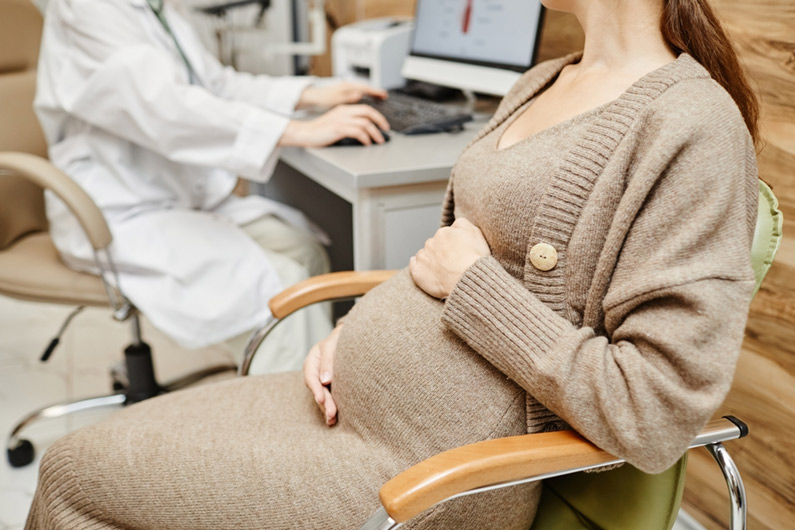So you’re pregnant—congratulations! Whether this is your first time or your third (or more!), it’s always exciting to think about the day you’ll finally meet your little one. While it’s not quite the same as holding your baby in your arms, ultrasounds offer a special way to connect and get a sneak peek of the incredible life growing inside you. And guess what? You might get to see your baby as early as your third month! Ready to learn more about those milestone prenatal ultrasound appointments? Let’s go!

Source: SeventyFour /Shutterstock.com
What is a prenatal ultrasound?
A prenatal ultrasound, or fetal ultrasound, is a medical imaging technique used during pregnancy to create images of the developing fetus and the mother’s reproductive organs. It uses high-frequency sound waves to generate real-time images that allow healthcare providers to:
- Confirm pregnancy
- Determine gestational age and estimate the due date
- Monitor fetal growth rate and size throughout pregnancy
- Assess the development and structure of the baby’s organs and limbs
- Identify any potential congenital disabilities or abnormalities
- Check placental health and location
- Evaluate amniotic fluid levels
- Make informed decisions regarding prenatal care and management
Your ultrasound schedule: a glimpse into your baby’s world
You’ll probably have two standard ultrasounds during your pregnancy, but the exact number and timing can vary depending on your doctor’s recommendations.
First Trimester Ultrasound (around 8-12 weeks)
You may have your first ultrasound around 8 to 12 weeks into your pregnancy. Here’s what’s in store:
- See baby’s first picture: This ultrasound confirms that your little one is on their way, showing their early development.
- Hear the heartbeat: Listen closely for the heartbeat, a tiny thump-thump that assures you everything’s going smoothly.
- Get your due date: Your doctor may be able to use the scan to estimate a more accurate date.
- Check for extra cuteness: There’s even a chance to see if you’ve got a double dose of joy with twins or more.
Anatomy Scan (around 18-22 weeks)
This is the big one—the anatomy scan! Around 18 to 22 weeks, get ready to see your baby in more detail:
- Close in on baby’s close-up: This ultrasound gives you a closer look at your baby’s growth, from wiggly limbs to a developing face that’s starting to look oh-so-adorable.
- Explore your baby’s world: Check out those tiny fingers and toes, and maybe catch a glimpse of a yawn or a stretch—it’s like getting a sneak peek at their personality!
- Evaluate their health: Learn about your baby’s health as the ultrasound checks on their organs, like the heart, brain, and more.
- Have a gender reveal (if you’re curious): Want to know if it’s Team Blue or Team Pink? This scan can clue you in.
While the first trimester and anatomy ultrasounds are typically routine, your doctor may schedule additional ultrasounds depending on your individual circumstances. For example, in the later stages of pregnancy (around months eight or nine), your doctor might order an ultrasound to check your baby’s growth and position. During weeks 33 to 36, your baby is usually settling into the optimal birth position: Their head is down, nestled near the cervix, with their face turned towards your back.
Your doctor may also want to assess the placenta’s health or monitor amniotic fluid levels. Plus, if you’re carrying multiples, your doctor might recommend more frequent ultrasounds to monitor the babies’ development.
Prepping for Your Ultrasound
Your doctor will give you all the details on preparing for your ultrasound, but here’s what you might expect and some tips.
- You may need a full bladder. For some—but not all—ultrasounds, you might be asked to drink water beforehand and avoid peeing. A full bladder helps to lift your uterus, making it easier to get clear images of your baby.
- Wear comfy clothes. Wear loose-fitting, comfortable clothes that are easy to remove from your belly. You might be given a gown to wear during the exam.
- Bring a support crew. Feel free to bring your partner, a friend, or a family member for support. It can be an emotional and exciting experience, and having someone to share it with can make it even more special.
When Does a Baby’s Facial Features Form?
You might be surprised to learn that your baby’s facial features start to develop pretty early on in pregnancy. By around 7.5 weeks, their nose, eyes, and ears are already starting to take shape. But don’t expect to see a perfectly formed face just yet. Even if you had an ultrasound at this stage, your baby is only about the size of a blueberry!
When You Can See Your Baby’s Face
While your baby’s face starts developing early, it isn’t until the anatomy scan that you can clearly see their features on an ultrasound. This scan, which typically happens after month four (around weeks 18-22), is when things get really exciting! Depending on their position, you might see your little one yawning, sucking their thumb, or even smiling.
Gender Reveal: When Can You Find Out
If you’re eager to know whether you’re having a boy or girl and can’t wait for the big day, there are a couple of ways you can find out:
- Anatomy Scan
The most common way to find out your baby’s gender is during the mid-pregnancy anatomy scan. This ultrasound allows your doctor to get a detailed look at your baby’s development. If your little one is in the right position, they can usually determine the gender.
- Non-Invasive Prenatal Testing (NIPT)
If you want to find out sooner, some parents opt for NIPT, a simple blood test that can be done as early as 10 weeks. This test analyzes your blood for fragments of your baby’s DNA and can determine the gender with high accuracy.
Enjoy the Journey
Ultrasound appointments are not only medically important but also a special way to connect with your baby before they’re born. While the images might not always be crystal clear, each glimpse is a reminder of the incredible journey you’re on. Remember, every pregnancy is unique, and your ultrasound experiences may vary. Be sure to talk to your healthcare provider about any questions or concerns you might have. And most of all, cherish these magical moments of seeing your baby grow.




Leave a Reply